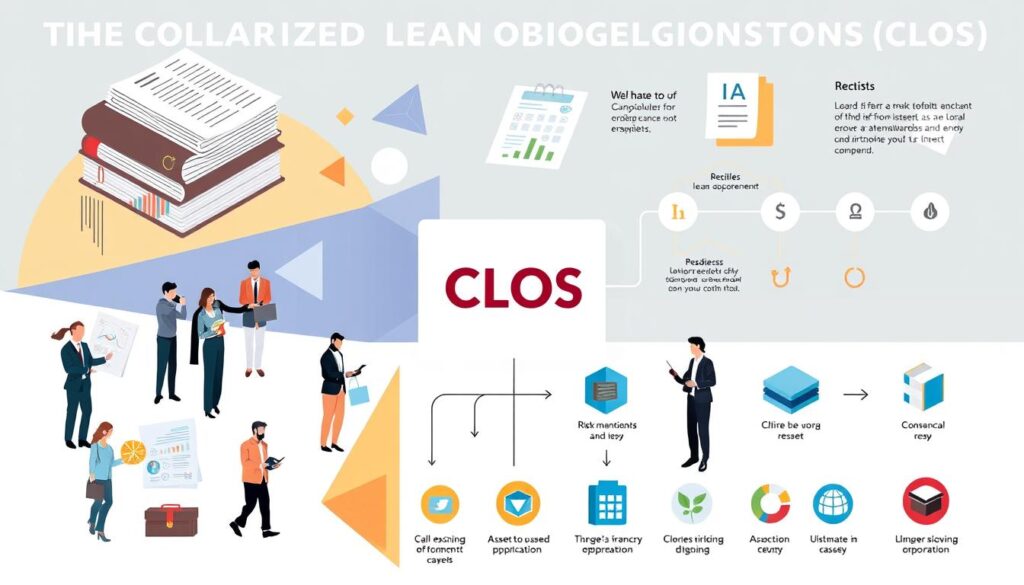Collateralized Loan Obligations (CLOs) are a huge part of the $12 trillion structured credit market, making up $970 billion. They let investors get into the high-yielding leveraged loan market. This offers high returns, growth, and floating-rate options with a solid track record.
CLOs are built from managed, mixed pools of non-investment grade, senior-secured corporate loans. These loans are first in line for the company’s assets, giving investors a safety net. The income from these loans is what CLOs are based on.
Key Takeaways
- CLOs represent a $970 billion asset class within the $12 trillion structured credit market.
- CLOs have historically demonstrated low default rates across the ratings spectrum compared to corporate debt.
- CLO portfolios are typically highly diversified, consisting of over 200 loans, providing a robust investment foundation.
- Leveraged loans, the primary collateral for CLOs, carry floating-rate coupons benchmarked to SOFR.
- CLO structures include a hierarchy of tranches, with AAA tranches representing the least risky portion of the capital structure.
Introduction to CLO Market Overview
Collateralized Loan Obligations (CLOs) have become a big part of today’s finance world. They started in the late 1980s as a way for banks to package loans. Since then, the CLO market has grown a lot.
The “modern” CLOs began in the mid-1990s, known as “CLO 1.0.” They have since changed with “CLO 2.0” after the financial crisis and “CLO 3.0” in 2014, following new rules like the Volcker Rule.
Historical Development of CLOs
The CLO market has grown a lot over the last 30 years. It has changed from the first CLO 1.0 to the more complex CLO 2.0 and 3.0. These changes have helped CLOs become a big part of the “shadow banking system.”
They work outside normal banking rules but still help securitize corporate loans. This has made CLOs very important in the finance world.
Current Market Size and Importance
Today, the global CLO market is worth $959 billion. The U.S. makes up 83% of this, and Europe has 17%. CLOs are now the biggest nonbank lender in the U.S.
They play a key role in providing credit risk transfer and leveraged loans to the corporate debt market.
Key Market Participants
The CLO market has many players, like asset managers, insurance companies, banks, and institutional investors. They all play important roles in creating and managing CLOs. Their knowledge helps them deal with the complex world of asset-backed securities (ABS).
| Participant | Role |
|---|---|
| Asset Managers | Actively manage CLO collateral portfolios, selecting and monitoring the underlying loans |
| Insurance Companies | Invest in CLO tranches, particularly the higher-rated debt instruments, as part of their fixed-income portfolios |
| Banks | Originate and structure CLOs, often utilizing their own balance sheets or those of their clients |
| Institutional Investors | Participate in the CLO market by investing in various tranches, seeking to diversify their fixed-income holdings |
Fundamentals of Collateralized Loan Obligations
Collateralized Loan Obligations (CLOs) are complex financial tools. They are a big part of the global debt market. CLOs are made from a group of syndicated loans, mostly from the leveraged loan market. These loans are split into risk tranches and sold to investors.
The main goal of CLOs is to make money from the difference in the loan’s yield and the cost of funding. This way, CLOs can earn income for investors. They also help financial institutions manage their credit risk.
| Key CLO Tranche Characteristics | Risk Tranching | Return Potential |
|---|---|---|
| Senior (AAA) Tranche | Lowest Risk | Lowest Return |
| Mezzanine (AA, A, BBB) Tranches | Medium Risk | Medium Return |
| Equity (Unrated) Tranche | Highest Risk | Highest Return |
CLOs are made of tranches, which are bonds that pay interest, and a small equity part. Each tranche has its own risk level and return. The top tranche has the best credit rating and lowest risk. The equity part is the riskiest and most volatile.
CLOs are issued through special purpose vehicles (SPVs). These are legal entities that help with the securitization process. SPVs buy the syndicated loans and then sell the CLO tranches to investors. Each tranche has its own risk and return.

Investors in CLOs can pick from different risk-return levels. This lets them match their investment goals with the right tranche. This flexibility makes CLOs appealing to many investors looking at the leveraged loan market.
CLO Structure and Components
Collateralized Loan Obligations (CLOs) are complex financial tools. They turn a group of high-risk loans into different parts, each with its own risk and reward. These parts, or tranches, go from the safest, top-rated AAA securities to the riskiest, equity tranches that get the last cash flows.
Tranches and Their Characteristics
A typical CLO has about 70% AAA-rated senior tranches. These offer low yields but are very safe. Next, there are 4-12% mezzanine tranches with higher yields but more risk. The equity tranches, making up 8-10%, are the riskiest but could offer the highest returns.
Waterfall Payment Structure
CLOs have a strict payment order. Cash flows go first to the safest tranches, then to the riskier ones. This order helps protect the top investors by making sure they get their payments first. Credit enhancements, like overcollateralization and interest rate swaps, make the senior tranches even safer.
Role of Special Purpose Vehicles
CLOs use a Special Purpose Vehicle (SPV) to keep the assets separate from the originator’s balance sheet. This setup makes the CLO more liquid and protects investors.
| Tranche | Credit Rating | Yield | Risk Level |
|---|---|---|---|
| Senior | AAA | Lowest | Lowest |
| Mezzanine | AA to BB | Higher | Higher |
| Equity | Unrated | Highest | Highest |
https://www.youtube.com/watch?v=LtqcRMp2EyY&pp=ygUHI3RvX2Nsbw%3D%3D
Understanding Leveraged Loans as CLO Assets
Leveraged loans are key for collateralized loan obligations (CLOs). These loans, rated BB+ or lower, offer steady interest and are easy to trade. They also have high recovery rates. By June 2021, the U.S. had $1.26 trillion and Europe had €252 billion in these loans.
These loans come from many issuers. They are valued for their income and risk reduction in CLOs. Loan syndication, credit derivatives, and pooling are used to create them. These loans then back CLOs.
Leveraged loans are appealing for their income and safety. They are especially sought after after the COVID-19 pandemic. But, it’s important to know the risks. These include liquidity, interest rate, credit, call, default, and economic risks.

CLOs usually have 150 to 250 loans in their pools. This diversity helps CLO managers improve returns for investors.
“CLOs make up 65%–70% of investor demand for leveraged loan products, making them a significant player in the loan markets.”
As the CLO market grows, knowing about leveraged loans is key. It’s vital for investors and financial experts in the complex world of CLOs.
CLO Investment Process and Lifecycle
The lifecycle of CLO managers has several phases, each with its own goals. Knowing this lifecycle is key for portfolio management and handling cash flow structures in the CLO market.
Warehousing Phase
The warehousing phase lasts 3-6 months. During this time, the CLO manager buys the initial collateral. This phase is vital for setting up the CLO’s cash flow structures and preparing for the next phase.
Ramp-up Period
The ramp-up period comes after the warehousing phase, lasting 1-6 months. Here, CLO managers finish the original portfolio. They ensure it meets diversification and credit quality standards before starting the reinvestment period.
Reinvestment Period
The reinvestment period can last 1-5 years. It lets CLO managers actively manage the portfolio. They buy and sell loans to enhance cash flow structures and portfolio management, aiming to improve the CLO’s performance.
| CLO Lifecycle Stage | Duration | Key Objectives |
|---|---|---|
| Warehousing | 3-6 months | Purchase initial collateral |
| Ramp-up | 1-6 months | Complete original portfolio |
| Reinvestment | 1-5 years | Active portfolio management |
| Non-call Period | 0.5-2 years | Protect investor interests |
| Repayment and Deleveraging | 1-4 years | Distribute proceeds from underlying loans |
The CLO structure also includes a non-call period, lasting 0.5-2 years, to safeguard investors from early refinancing. After this, the CLO can be refinanced. The final stage involves paying off the loans, with the money going to investors.
https://www.youtube.com/watch?v=WTXEhruJSME&pp=ygUII2Nsb2R1dHk%3D
Understanding the CLO investment process and lifecycle is vital for CLO managers. It helps them navigate the market, manage cash flow structures, and improve portfolio management strategies.
Risk Management in CLO Investments
Collateralized Loan Obligations (CLOs) have strong risk management tools. These tools help protect investors from credit risks. They also make sure the portfolio can pay back interest and principal on time.
CLOs use coverage tests like interest coverage and overcollateralization tests. These tests check how well the portfolio is doing. They help find and fix any problems with the collateral. This way, CLOs can keep investors safe and make sure payments are made on time.
CLOs also have a rule for diversifying the portfolio. They must invest in senior secured loans and spread out across many borrowers and industries. This strategy helps lower risks by not putting all eggs in one basket. It makes the CLO structure safer for investors.
The CLO structure also has a subordination feature. It divides the capital structure into different tranches. Each tranche has its own level of risk and return. This lets investors choose how much risk they want to take, based on their goals and comfort level.
| Key Risk Management Features in CLOs | Purpose |
|---|---|
| Coverage Tests | Detect and correct collateral deterioration, ensuring the portfolio’s ability to cover interest and principal payments |
| Diversification Requirements | Reduce concentration risk by diversifying the portfolio across borrowers and industries |
| Subordination Mechanism | Offer investors the ability to select their desired risk-return profile based on their investment preferences |
CLOs use these strong risk management features to offer investors a safe way to invest in the leveraged loan market. They help reduce credit risks and improve the risk management of the investment.

CLO Portfolio Management Strategies
Collateralized Loan Obligation (CLO) managers work hard to reduce losses from loan defaults. They aim to increase value for investors. They use different strategies to deal with the changing debt tranching world and meet investor needs.
Active Management Approach
CLO managers are very hands-on in managing their portfolios. They keep a close eye on the loans and look for market chances. They buy and sell bank loans to manage risk and boost returns.
This approach helps them adjust to market changes. It also makes sure the CLO performs well over its life.
Portfolio Diversification Techniques
Diversification is key in CLO portfolio management. CLO managers use various methods to diversify. This includes:
- Limiting industry exposure: They set limits on how much of the portfolio can be in one industry to avoid too much risk.
- Controlling single obligor concentration: They keep a tight limit on how much of the portfolio can be tied to one borrower or company.
- Careful CCC-rated loan inclusion: They watch closely how many CCC-rated loans are in the portfolio to balance risk and reward.
These strategies help CLO managers balance risk and reward. They make sure the portfolio meets structural rules and investor wishes.
The debt tranching and active management of CLO investors‘ portfolios are key parts of the asset securitization process. They help CLO managers handle the complex world of the $1.0 trillion CLO market.
“CLO managers must strike a delicate balance between maximizing returns and mitigating risks, leveraging their expertise to navigate the ever-evolving debt markets.”
Credit Enhancement Mechanisms
Collateralized Loan Obligations (CLOs) use several ways to protect investors, especially those with higher-rated credit tranches. These methods include subordination, overcollateralization, excess spread, and performance-based tests. It’s key for institutional investors to know these techniques when looking at CLO investments.
Subordination is a key strategy in CLOs. It structures the capital into different credit rating tranches. This means the more senior tranches are safe from losses by the junior tranches. If there are defaults, the junior tranches take the hit first, protecting the senior debt.
- Overcollateralization makes sure the loan portfolio’s value is more than the CLO debt. This extra value helps protect against losses.
- Excess spread is the difference between what the loan portfolio earns and what the CLO debt costs. It acts as a safety net against defaults.
- Performance-based tests, like coverage ratios and collateral quality tests, kick in if the portfolio’s quality drops. They can send cash to pay down senior debt, improving credit quality.
| Credit Enhancement Mechanism | Description |
|---|---|
| Subordination | The structuring of the CLO capital into different tranches, where junior tranches absorb initial losses to protect senior tranches. |
| Overcollateralization | Ensuring the total value of the loan portfolio exceeds the outstanding CLO debt, providing an additional cushion against losses. |
| Excess Spread | The difference between the interest earned on the loan portfolio and the interest paid on the CLO debt, acting as a buffer against defaults. |
| Performance-based Tests | Triggers that redirect cash flows to pay down senior debt if the portfolio’s quality deteriorates, strengthening credit enhancement. |
CLOs aim to offer institutional investors safer and higher-rated investment options than the underlying credit tranches through these mechanisms.

CLO Performance Analysis
The collateralized loan obligation (CLO) market has shown great strength through tough times. This includes the 2008 financial crisis and the COVID-19 pandemic. CLO tranches, especially those with high ratings, have very low default rates. This is because the loans backing CLOs are secured and the structure of CLOs spreads out risk.
Historical Default Rates
Rating agencies’ data shows CLO tranches have much lower default rates than similar corporate bonds. For example, AAA-rated CLO tranches have a default rate under 1% over the last 20 years. This is much lower than the 5% rate for similar corporate bonds.
Recovery Statistics
Leveraged loans, the main collateral for CLOs, have historically recovered about 70% of their value. This is better than the 40-50% recovery for high-yield bonds. The loans’ senior secured status and the spread of risk in CLOs help achieve these high recovery rates.
| Metric | CLO Tranches | Corporate Bonds |
|---|---|---|
| Cumulative Default Rates (AAA-rated) | Less than 1% | Around 5% |
| Average Recovery Rates (Leveraged Loans) | Around 70% | 40-50% (High-yield Bonds) |
CLOs have shown strong performance with low default rates and high recovery rates. This success highlights the strength of debt securitization, the cash flow waterfalls, and the careful work of rating agencies.

“The resilience of CLOs during the financial crisis and their impressive performance in the aftermath have been key factors in their growing popularity among institutional investors.”
As the debt securitization market evolves, CLOs look promising. Investors watch closely as economic cycles, regulations, and rating agency methods improve.
Regulatory Framework and Compliance
The collateralized loan obligation (CLO) market has a strong financial regulatory framework. This framework affects how these complex financial tools are structured, managed, and used. Key rules include the Dodd-Frank Act and the Volcker Rule in the U.S., and the EU Securitisation Regulation in Europe.
The Dodd-Frank Act requires CLO managers to own at least 5% of the CLO they manage. This rule helps managers and investors share the same goals, promoting careful risk-taking. The Volcker Rule once limited banks from investing in certain CLOs. But changes in 2020 have made it easier for banks to join the CLO market.
For CLO market players, following rules is key. The EU Securitisation Regulation sets standards for transparency and reporting. This ensures investors get all the details they need about the CLOs they’re looking at.
- Year-end forecasts for CLO new issuance are expected to exceed over $100 billion.
- The CLO market demands over half of the domestic leveraged loan issuance.
- New CLO asset managers continue to enter the market, indicating a growing base of participants.
The changing rules bring both challenges and chances for the CLO market. To grow and stay stable, CLO issuers, managers, and investors must follow the financial regulatory framework. They also need to manage risk-weighted assets and keep up with regulatory compliance.

Market Participants and Their Roles
The CLO market has many players, each key to its smooth operation. From collateral managers to credit default swaps traders, they all work together. They create, structure, and manage CLO equity investments.
CLO managers are the heart of the industry. They pick and manage the loan portfolios. Their skills in credit analysis and portfolio building make sure the loans perform well.
Underwriters are crucial for structuring and selling CLO securities. They use their knowledge and networks to bring in capital. This helps the CLO market grow.
| Participant | Role |
|---|---|
| CLO Managers | Select and manage the underlying loan portfolio |
| Underwriters | Structure and distribute CLO securities |
| Trustees | Oversee compliance with transaction documents |
| Rating Agencies | Assess the credit quality of CLO tranches |
| Investors | Vary by tranche, with banks and insurance companies typically holding senior tranches, while hedge funds and specialized CLO investors often target mezzanine and equity tranches |
Trustees make sure CLO deals follow their rules. They act as fair third parties, protecting investor interests.
Rating agencies like Moody’s, S&P, and Fitch rate CLO tranches. Their ratings help investors understand the risks and rewards of their investments.
Investors in the CLO market vary. Banks and insurance companies go for safer senior tranches. But hedge funds and specialized investors aim for riskier mezzanine and equity tranches for higher returns.

The work of these market players makes the CLO market dynamic and strong. Each one brings their own skills and duties to the table.
Investment Considerations for CLO Investors
When looking at Collateralized Loan Obligations (CLOs), investors need to think about several things. These include the quality of the loans, the manager’s track record, and the structure of the CLO. It’s also important to consider the market conditions. Looking at CLO liabilities, CLO structuring, and special purpose vehicles (SPVs) helps manage risks and aim for the right returns.
Risk Assessment Methods
Assessing risk in CLOs means checking the loan quality, tranche ratings, and stress tests. Investors should look at the credit of the loans, how diverse the portfolio is, and the CLO’s structural protections. Knowing the risks and how they affect different tranches is key to smart investing.
Return Expectations
The returns on CLOs depend on the tranche. CLO equity can offer high returns but comes with high risk. Investment-grade tranches, though, have higher yields than corporate bonds but are more complex and less liquid. Investors must weigh the risk against the potential return when picking CLOs.
| Tranche | Risk Profile | Yield Expectations |
|---|---|---|
| Equity | High | Double-digit returns |
| Investment Grade | Low | Higher than similarly rated corporate bonds |
Understanding CLO liabilities, CLO structuring, and the role of SPVs helps investors tackle the CLO market’s complexities. This knowledge allows them to craft strategies that meet their investment goals.

CLO Market Trends and Evolution
The Collateralized Loan Obligation (CLO) market has changed a lot since it started. It now meets the needs of investors and the financial world better. ESG-focused CLOs are becoming more popular. The market also has more standard documents, making things clearer and more efficient.
The CLO market is moving away from the London Interbank Offered Rate (LIBOR) to rates like the Secured Overnight Financing Rate (SOFR). This change means everyone in the market has to adjust how they work and price things. It’s making the switch to the new rate smoother.
Investors are now asking for CLOs that can be used faster and with tighter spreads. New technology is helping with analyzing portfolios and trading. This could make the market more efficient and liquid.
| Metric | 2023 | 2024 |
|---|---|---|
| CLO Issuance (US$ Billion) | $145 | $155 |
| CLO Pricing (All-in Yields) | Historically High | N/A |
| Leveraged Loan Defaults | 1.5% | 4.2% |
| Loan Recoveries | 50% – 60% | N/A |
| CLOs Exited Reinvestment Period | 40% | N/A |
These trends show how the CLO market is always changing. As the debt repackaging world keeps evolving, everyone needs to keep up. This way, they can find new chances and deal with the changing rules and market.
“The CLO market has shown great strength, facing new challenges and using new tech to get better and attract more investors.”
Impact of Economic Cycles on CLOs
Collateralized loan obligations (CLOs) are closely linked to the economy. Their success depends on the ups and downs of economic cycles. When the economy grows, CLOs do well. This is because the loans they hold get better and market conditions are good.
But, when the economy slows down, CLOs face big challenges. Default rates on the loans they hold might go up. This could lead to CLOs using special protection for investors. We saw this in the 2008 crisis and during the COVID-19 pandemic. Luckily, most CLOs kept their ratings high, avoiding defaults.
CLOs have a mix of loans and are managed by experts. Rules in CLOs, like limits on bad loans, help keep default rates low. Also, the chance to change investments in different times helps CLO equity do well.
Economic cycles do affect CLOs, but their structure and management help them stay strong. As the world’s economy stays uncertain, CLOs will face more tests. This will show their value in the fixed-income world.
| Key Statistics | Impact on CLOs |
|---|---|
| New CLO issuance in the US up 30% YoY in Q1 2023 to $40.4 billion | Robust demand for CLOs in the US market |
| New CLO issuance in Europe down 33% YoY in Q1 2023 to €6.7 billion | Softening demand for CLOs in the European market |
| CLO ETFs now hold $2.8 billion in assets under management | Increasing institutional interest and exposure to the CLO market |
| CLO financing costs-to-loan yields spread reduced to 2% in April 2023 | Improved profitability and returns for CLO investments |
As the economy changes, the effect on collateralized debt obligations, subprime loans, and credit risk transfer is key for investors. Knowing how CLOs adapt to economic changes helps investors make smart choices. This way, they can take advantage of the changing investment world.

Comparing CLOs with Other Fixed Income Investments
Collateralized Loan Obligations (CLOs) stand out in the world of fixed income. They often give higher returns than corporate bonds of the same rating. This is because they are more complex and less liquid. Yet, they have lower default rates than similar corporate bonds, especially in top-rated tranches.
CLOs’ floating-rate structure helps shield them from rising interest rates. Yet, they can be more affected by credit market changes. They also might be less liquid when markets are stressed.
Risk-Return Profile Analysis
The J.P. Morgan CLO Index has beaten the ICE BofA US Corporate Index and the ICE BofA US High Yield Index over time. The AAA-rated CLOs in the J.P. Morgan CLO AAA Index have shown very low default risk. They have only seen 40 defaults out of over 12,500 S&P-rated CLO tranches.
Market Correlations
- CLOs show lower correlation to traditional corporate bonds than other structured credit products, like credit default swaps.
- The Morningstar LSTA US Leveraged Loan 100 Index tracks institutional leveraged loans. It has a low correlation to the broader fixed income market.
- CLOs’ diversified portfolios and focus on the senior part of the capital structure make them unique. They offer a lower risk-return profile and lower market correlations.
In summary, securitized debt instruments like CLOs are a good choice for investors looking for something different from traditional fixed income. They offer the chance for higher yields and lower default risk. Their structured credit products and credit enhancements can also add diversification and protection against rising interest rates.
Future Outlook for CLO Markets
The collateralized loan obligation (CLO) market is set to grow, thanks to strong investor demand for returns. The need for leveraged loan financing also drives this growth. Despite possible hurdles like regulatory changes and interest rate swings, the CLO market is ready to adapt.
New CLO structures, like static and middle-market CLOs, could make the market more appealing. The growing importance of ESG factors will shape CLOs and the loans they hold. This is because investors want to invest in sustainable ways.
Technology will make the CLO market more efficient and open to more investors. We can expect better data analytics, risk management tools, and trading platforms. These changes will help more people get involved in CLOs.
In summary, the outlook for CLO markets is bright. CLO issuance, securitized loans, and syndicated lending will keep being key in finance. As the market changes, all stakeholders must understand its complexities and benefits.
“The CLO market is expected to continue growing, driven by investor demand for yield and the ongoing need for leveraged loan financing.”
Conclusion
Collateralized Loan Obligations (CLOs) are a big part of the structured finance and securitization markets. They offer investors a chance to invest in leveraged loans with different levels of risk and return. The CLO market might seem complicated, but these financial tools have many benefits.
They help diversify portfolios, can offer higher yields, and have strong structural protections. This makes them a valuable choice for many investors.
As the market grows, it’s key to understand CLOs well. Knowing their risks and how they fit into the fixed income world is important. The data shows CLOs can provide good yields, be resilient against defaults, and add diversity to portfolios.
This makes them a great option for many investors. The CLO market’s success shows its important role in helping the leveraged loan sector. It also gives investors new ways to meet their investment goals.
By staying up-to-date and careful, investors can make the most of the CLO market. They can take advantage of its unique benefits while handling the risks.
FAQ
What are Collateralized Loan Obligations (CLOs)?
What is the current size of the CLO market?
What are the key components of a CLO structure?
What is the role of leveraged loans in CLOs?
FAQ
What are Collateralized Loan Obligations (CLOs)?
CLOs are a type of structured credit product. They get their income from a mix of corporate loans. These loans are not for investment and are secured by assets.
What is the current size of the CLO market?
The CLO market is now worth 9 billion worldwide. In the US, 83% of this is CLOs, while Europe accounts for 17%.
What are the key components of a CLO structure?
A CLO has different parts, like interest-paying bonds and a small equity piece. These parts are ranked by risk and income. This ranking helps manage the risk.
What is the role of leveraged loans in CLOs?
Leveraged loans are key for CLOs. They provide income and help manage risk. As of June 2021, there were
FAQ
What are Collateralized Loan Obligations (CLOs)?
CLOs are a type of structured credit product. They get their income from a mix of corporate loans. These loans are not for investment and are secured by assets.
What is the current size of the CLO market?
The CLO market is now worth $959 billion worldwide. In the US, 83% of this is CLOs, while Europe accounts for 17%.
What are the key components of a CLO structure?
A CLO has different parts, like interest-paying bonds and a small equity piece. These parts are ranked by risk and income. This ranking helps manage the risk.
What is the role of leveraged loans in CLOs?
Leveraged loans are key for CLOs. They provide income and help manage risk. As of June 2021, there were $1.26 trillion in US loans and €252 billion in Europe.
How do CLO managers actively manage the portfolio?
CLO managers work to reduce losses and increase value. They buy and sell loans to take advantage of market chances or to protect against bad credits.
What are the key credit enhancements in CLOs?
CLOs use several ways to protect investors, like subordination and overcollateralization. These methods help cover payments and absorb losses.
How have CLOs performed during economic cycles?
CLOs have shown strength during tough times, like the 2008 crisis and the COVID-19 pandemic. Their default rates are lower than similar corporate bonds.
What regulations govern the CLO market?
CLOs follow rules like the Dodd-Frank Act and the Volcker Rule in the US. The EU Securitisation Regulation also applies. These rules affect risk, transparency, and reporting.
What are the key factors investors should consider when evaluating CLOs?
Investors should look at the loan quality, the manager’s track record, and the structure. They should also consider market conditions and risk levels.
What are the current trends in the CLO market?
The market is seeing more ESG-focused CLOs and standardized documents. There’s a move to alternative rates like SOFR. Spreads are getting tighter due to strong demand.
.26 trillion in US loans and €252 billion in Europe.
How do CLO managers actively manage the portfolio?
CLO managers work to reduce losses and increase value. They buy and sell loans to take advantage of market chances or to protect against bad credits.
What are the key credit enhancements in CLOs?
CLOs use several ways to protect investors, like subordination and overcollateralization. These methods help cover payments and absorb losses.
How have CLOs performed during economic cycles?
CLOs have shown strength during tough times, like the 2008 crisis and the COVID-19 pandemic. Their default rates are lower than similar corporate bonds.
What regulations govern the CLO market?
CLOs follow rules like the Dodd-Frank Act and the Volcker Rule in the US. The EU Securitisation Regulation also applies. These rules affect risk, transparency, and reporting.
What are the key factors investors should consider when evaluating CLOs?
Investors should look at the loan quality, the manager’s track record, and the structure. They should also consider market conditions and risk levels.
What are the current trends in the CLO market?
The market is seeing more ESG-focused CLOs and standardized documents. There’s a move to alternative rates like SOFR. Spreads are getting tighter due to strong demand.
